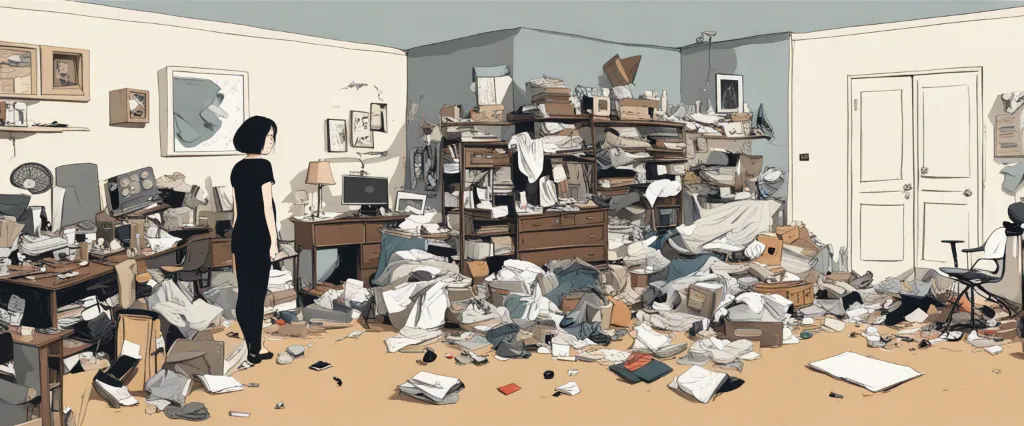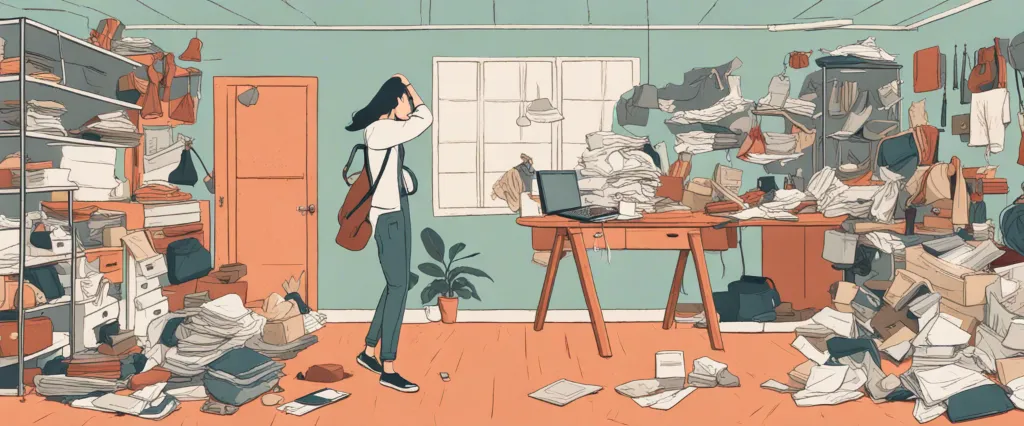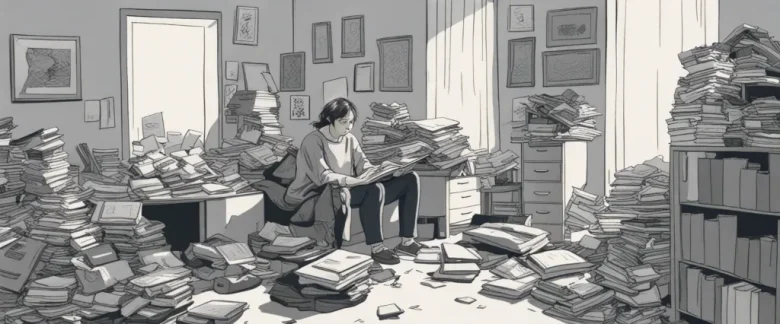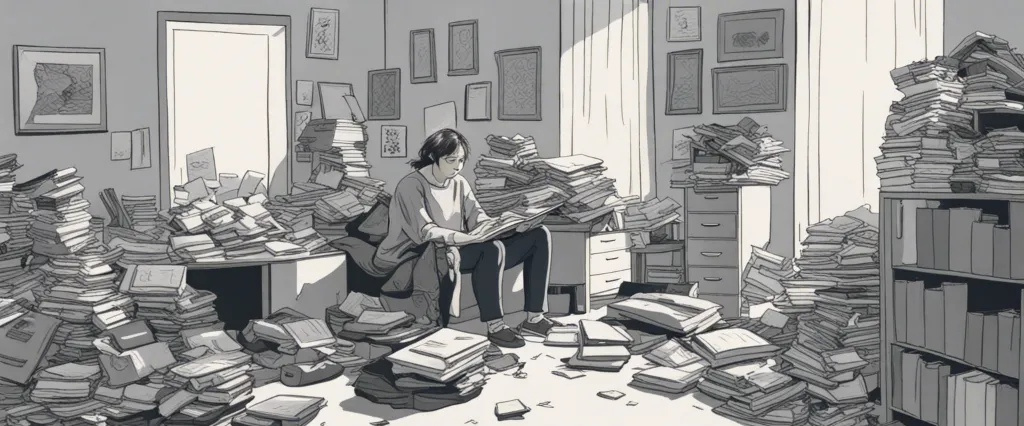In
Chapter 1: Understanding the clutter problem and its impact
Chapter 1 of “It’s All Too Much” by Peter Walsh provides an understanding of the clutter problem and its impact on individuals’ lives. The chapter begins by highlighting how clutter has become an epidemic, affecting millions of people across the globe. Walsh emphasizes that clutter is not just a physical issue but also impacts mental and emotional well-being.
The author delves into the negative consequences clutter can have on various aspects of life, starting with the physical effects on health. Cluttered spaces often lead to hygiene issues, allergies, and difficulties in finding essential items when needed. Walsh argues that clutter also affects relationships, as it can create tension and distance between individuals. Additionally, it hampers productivity by causing distractions and wasting time.
The chapter further explores the emotional impact of clutter, explaining how living in a disorganized environment can contribute to stress, anxiety, and even depression. Walsh emphasizes that clutter represents unfinished business, both physically and emotionally, and can prevent individuals from moving forward in their lives.
To emphasize the severity of the clutter problem, Walsh shares a couple of real-life stories from his clients who have faced serious consequences due to their cluttered living conditions. These stories serve as cautionary examples and illustrate the need to address clutter before it escalates into a more significant issue.
In conclusion, Chapter 1 of “It’s All Too Much” provides a comprehensive overview of the clutter problem and its impact on individuals’ overall well-being. By highlighting the physical, relational, and emotional consequences of clutter, Peter Walsh sets the stage for the rest of the book, offering solutions and guidance to help readers regain control over their living spaces and lives.
Chapter 2: Decluttering your physical environment for a peaceful home
Chapter 2 of “It’s All Too Much” by Peter Walsh focuses on decluttering your physical environment to achieve a peaceful home. The chapter begins by emphasizing the direct relationship between the amount of stuff we own and the clutter in our lives, hence the need to declutter.
Walsh starts by discussing the importance of setting goals before commencing the decluttering process. He suggests visualizing and defining your ideal living space, identifying the purpose of each room, and determining how you want to feel in those spaces. By establishing these goals, you create a clear vision and motivation for decluttering.
Next, Walsh teaches a technique called the “Power of First Steps.” He emphasizes the significance of starting small and focusing on one area or room at a time to avoid feeling overwhelmed. The process involves sorting items into three categories: keep, toss, or donate/sell. Walsh advises being ruthless in determining what truly adds value to your life and letting go of unnecessary possessions.
The chapter also covers common decluttering challenges, such as sentimental attachments to items, dealing with gifts, and managing hobbies and collections. Walsh provides practical tips and strategies for overcoming these challenges, encouraging readers to evaluate the true emotional worth of possessions and prioritize their emotional well-being over material items.
Additionally, Walsh stresses the importance of creating functional storage solutions to maintain a clutter-free environment. He suggests utilizing various storage methods, such as clear containers and labeling systems, to help you easily find and access your belongings.
In summary, Chapter 2 of “It’s All Too Much” highlights the key principles for decluttering your physical environment to achieve a peaceful home. It emphasizes setting clear goals, starting small, being decisive in categorizing possessions, confronting sentimental attachments, and implementing functional storage solutions. By following these strategies, readers can create harmony and serenity in their living spaces.
Chapter 3: Organizing and creating functional storage solutions
Chapter 3 of “It’s All Too Much” by Peter Walsh, titled “Organizing and Creating Functional Storage Solutions,” delves into the process of effectively managing and decluttering different areas of your home by incorporating practical storage solutions.
Walsh begins by emphasizing the importance of sorting through possessions and categorizing them based on their function and frequency of use. He suggests applying his “Three-Step” approach: analyze, visualize, and prioritize. This involves evaluating your belongings, envisioning how your space could be optimized, and determining which items deserve priority in your living areas.
Next, Walsh explores various storage options, including shelves, baskets, cabinets, and bins. He highlights the significance of choosing the right storage containers based on the specific items they will house. Additionally, he encourages readers to maximize their available space by utilizing vertical storage, such as adjustable shelves or wall-mounted organizers.
Walsh also shares his insights on furniture selection, stressing the importance of functional pieces that serve storage purposes. For instance, he suggests investing in furniture that incorporates hidden compartments, such as ottomans or coffee tables with concealed storage, to reduce clutter.
Moreover, the author recognizes the psychological impact of an organized living space on one’s well-being. He advocates for creating storage solutions that reflect one’s personal style and preferences, as this increases the likelihood of maintaining an organized environment. Walsh advises individuals to consider color-coding or labeling containers for easier retrieval and replacement.
Throughout the chapter, Walsh emphasizes the importance of regularly reviewing and adjusting storage solutions as needs change over time. He underscores the idea that organizing is not a one-time task but rather an ongoing process that requires constant reassessment and alteration to accommodate new possessions.
In conclusion, Chapter 3 of “It’s All Too Much” provides readers with practical strategies for organizing their belongings and creating functional storage solutions tailored to their needs. By applying this knowledge, one can transform their living space into an organized and clutter-free oasis.
Chapter 4: Letting go of emotional attachments to possessions

In Chapter 4 of “It’s All Too Much” by Peter Walsh, the focus shifts towards letting go of emotional attachments to possessions. Walsh acknowledges that sentimental attachments often hinder decluttering efforts and prevent people from creating a more organized and spacious living environment.
Walsh starts by explaining that emotional attachments to possessions are common, but they can hold people back from experiencing freedom and clarity in their lives. He emphasizes that it is crucial to reassess the emotions tied to each item and determine if they truly bring joy and value, or if they are mere clutter.
The chapter introduces a four-step process to help individuals let go of emotional attachments. Firstly, Walsh encourages readers to identify their attachments by categorizing possessions into different groups like family, friends, experiences, and identity. By understanding the emotional significance of each group, people can gain insight into the attachments that may be hindering their ability to declutter.
Secondly, Walsh suggests reflecting on the impact these attachments have on one’s life. Are they positive or negative? Do they contribute to a healthy and fulfilling environment or cause stress and overwhelm? By evaluating the effects, individuals can prioritize their happiness over emotional clutter.
The third step involves choosing to let go of some attachments. Walsh advises readers to start with nonessential items and gradually work towards the more sentimental possessions. He recommends finding alternative ways to preserve the memories associated with those items, such as taking pictures or creating a memory box with a few select objects.
Finally, Walsh emphasizes the importance of self-empathy. Decluttering and letting go of emotional attachments can be challenging and emotional, so it is crucial to be kind to oneself throughout the process. Accepting the occasional setback or struggle is part of the journey towards freedom from clutter and a more organized life.
In summary, Chapter 4 of “It’s All Too Much” guides readers through the process of letting go of emotional attachments to possessions. By categorizing attachments, evaluating their impact, gradually releasing them, and practicing self-empathy, individuals can create a living environment that is free from the burden of unnecessary clutter and filled with joy and fulfillment.
Chapter 5: Developing healthy habits for maintaining an organized life
Chapter 5 of “It’s All Too Much” by Peter Walsh focuses on developing healthy habits for maintaining an organized life. The chapter starts by emphasizing the importance of consistency and routine in sustaining an organized and clutter-free environment. Walsh highlights that without developing these habits, it is easy to fall back into chaos and disorganization.
The chapter discusses several key habits for maintaining order. Firstly, Walsh suggests creating a daily organizing routine, which involves spending 15 minutes each day tidying up and putting things back in their designated places. This small commitment ensures that clutter does not accumulate over time.
Additionally, Walsh emphasizes the significance of regular decluttering sessions. He suggests setting aside specific times throughout the year for decluttering different areas of the home. This practice helps prevent excessive accumulation of unnecessary items and allows for a more organized living space.
Furthermore, Walsh addresses the importance of being proactive in preventing clutter. He encourages readers to adopt the “one in, one out” rule, meaning that for every new item brought into the house, one must be removed. This habit helps maintain a balanced and clutter-free environment.
Another significant habit discussed is the development of a paper management system. Walsh advises implementing an organized method for dealing with paperwork, such as sorting mail immediately and designating specific places for bills and important documents. This prevents paper clutter from piling up and becoming overwhelming.
Lastly, the chapter stresses the importance of maintaining a realistic perspective on possessions. Walsh notes that letting go of sentimental attachments to items and recognizing the difference between wants and needs is essential for maintaining an organized life.
In summary, Chapter 5 of “It’s All Too Much” focuses on developing healthy habits for maintaining an organized life. These habits include implementing a daily organizing routine, regular decluttering sessions, being proactive in preventing clutter, establishing a paper management system, and maintaining a realistic perspective on possessions. By adopting these habits, readers can create and maintain a clutter-free and organized living space.
Chapter 6: Managing digital clutter and simplifying technology
Chapter 6 of “It’s All Too Much” by Peter Walsh focuses on managing digital clutter and simplifying technology. The chapter starts by highlighting how our dependence on technology and gadgets often leads to digital clutter that overwhelms our lives.
Walsh emphasizes the importance of taking control of digital clutter, which includes organizing emails, documents, photos, and digital devices. He suggests setting up a system to manage emails, such as sorting them into folders and unsubscribing from unnecessary subscriptions. By decluttering inboxes, individuals can save time and reduce stress.
Furthermore, Walsh provides tips on organizing digital files and documents by creating specific folders and subfolders, allowing for easy access and retrieval. He encourages individuals to regularly review and delete unnecessary files, freeing up digital space and promoting an organized digital environment.
Another aspect of managing digital clutter is addressing the countless photos stored on devices. Walsh recommends sorting and categorizing photos into albums, deleting duplicates and low-quality images, and considering printing and displaying memorable ones. This enables individuals to enjoy their cherished memories without being weighed down by an overwhelming digital collection.
Additionally, Walsh addresses the issue of excessive reliance on digital devices and the importance of simplifying technology. He encourages readers to evaluate their use of gadgets and limit their dependency on them. By reducing the number of devices and apps, individuals can streamline their digital lives and reduce technological overwhelm.
Overall, Chapter 6 emphasizes the significance of managing digital clutter and simplifying technology to create a more organized and stress-free digital life. Walsh’s practical tips and strategies provide readers with actionable steps to regain control over their digital presence.
Chapter 7: Creating a clutter-free mindset and embracing minimalism
Chapter 7 of “It’s All Too Much” by Peter Walsh focuses on developing a clutter-free mindset and embracing minimalism. Walsh starts by emphasizing the importance of understanding why clutter accumulates in our lives. He suggests that holding onto objects often represents a connection to the past or a fear of the future, creating emotional attachments.
To initiate a clutter-free mindset, Walsh suggests understanding that decluttering is not about throwing everything away. Instead, it involves the mindful consideration of the things we choose to keep and ensuring they hold value or functionality in our lives. This mental shift helps us let go of unnecessary items and prioritize what truly matters.
Walsh introduces the concept of minimalism, which promotes owning and surrounding ourselves with only the things that bring us joy or serve a purpose. He advises readers to envision a life with fewer possessions, promoting a calmer and more organized environment. To embrace minimalism, Walsh recommends evaluating our possessions with a critical eye, asking ourselves if they truly add value to our lives or if they are merely taking up space.
The chapter also highlights the beneficial effect of decluttering on mental and emotional well-being. Walsh suggests that decluttering creates a physical and mental space that allows us to focus on what truly matters, brings clarity, reduces stress, and improves overall quality of life.
Towards the end, Walsh advises readers to approach decluttering in small manageable steps, creating a plan with achievable goals to avoid becoming overwhelmed. By cultivating a clutter-free mindset and embracing minimalism, he believes we can regain control over our possessions and create a more meaningful and fulfilling life.

Chapter 8: Sustaining long-term clutter-free living and enjoying the benefits
Chapter 8 of “It’s All Too Much” by Peter Walsh focuses on sustaining long-term clutter-free living and enjoying the benefits that come with it. The chapter emphasizes the importance of changing one’s mindset and creating new habits to ensure a clutter-free lifestyle indefinitely.
Firstly, Walsh emphasizes the need for ongoing maintenance. He suggests dedicating a few minutes each day to decluttering and organizing, rather than letting things accumulate. This regular practice helps to prevent clutter from building up and becoming overwhelming again.
The chapter also delves into the concept of letting go. Walsh advises individuals to constantly reassess their possessions and be willing to let go of items that no longer serve a purpose or bring joy. He encourages readers to embrace the idea of “just enough” rather than constantly accumulating more.
Walsh provides techniques for avoiding future clutter, such as implementing proper storage systems and creating designated spaces for specific items. This helps individuals easily find what they need and reduces the likelihood of clutter piling up.
Furthermore, the chapter highlights the importance of being mindful of the clutter that enters the home. Walsh recommends practicing smart shopping habits and being more conscious of the items purchased. By focusing on needs over wants and making informed purchasing decisions, individuals can prevent unnecessary clutter from entering their lives.
Finally, Walsh emphasizes the positive impact of a clutter-free environment on mental and emotional well-being. He discusses the benefits of reduced stress, increased productivity, and improved relationships that come with maintaining an organized home.
Chapter 8 of “It’s All Too Much” serves as a guide for readers to sustain a clutter-free lifestyle in the long term. By adopting new habits, letting go of unnecessary items, implementing proper storage systems, practicing mindful shopping, and enjoying the numerous benefits, individuals can create a peaceful and organized living environment.
After Reading
In conclusion, “It’s All Too Much” by Peter Walsh provides readers with practical and insightful methods to declutter their lives and create a more organized and meaningful living space. Through his step-by-step approach, Walsh emphasizes the importance of understanding our emotional attachment to the objects in our homes and offers effective strategies to let go of unnecessary possessions. By taking control of our living environments, Walsh asserts that we can lead more fulfilling lives, free from the burden of excessive physical and mental clutter. With this valuable guide, readers are inspired to make positive changes and create a harmonious and balanced lifestyle.
1. “The Life-Changing Magic of Tidying Up” by Marie Kondo – This widely acclaimed book offers practical tips and a unique perspective on organizing and decluttering your living spaces, providing valuable insights on letting go of what no longer serves you.
2. “Clutterfree with Kids” by Joshua Becker – If you’re a parent struggling to maintain a clutter-free home with young children, this book is a must-read. Joshua Becker offers advice on how to foster a minimalist lifestyle while also addressing the challenges of raising a family.
3. “Unstuffed: Decluttering Your Home, Mind, and Soul” by Ruth Soukup – Soukup’s book provides guidance on decluttering not only physical spaces but also mental and emotional clutter. She explores how decluttering your living environment can positively impact other areas of your life.
4. “Simplify: Ten Practices to Unclutter Your Soul” by Bill Hybels – If you seek a more holistic approach to decluttering, this book is an excellent choice. Hybels shares practical techniques and spiritual insights to help you simplify your life and find peace of mind.
5. “Cluttered Mess to Organized Success Workbook: Declutter and Organize Your Home and Life with Over 100 Checklists and Worksheets” by Cassandra Aarssen provides practical tools and strategies to tackle clutter and create an organized environment. With its comprehensive checklists and worksheets, this workbook guides readers step-by-step towards a more streamlined and stress-free life.




